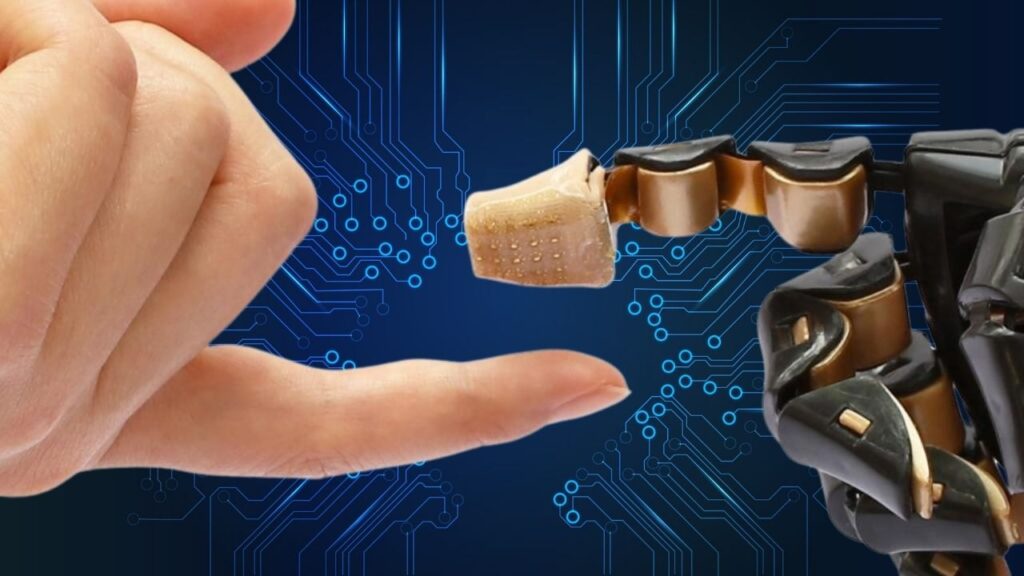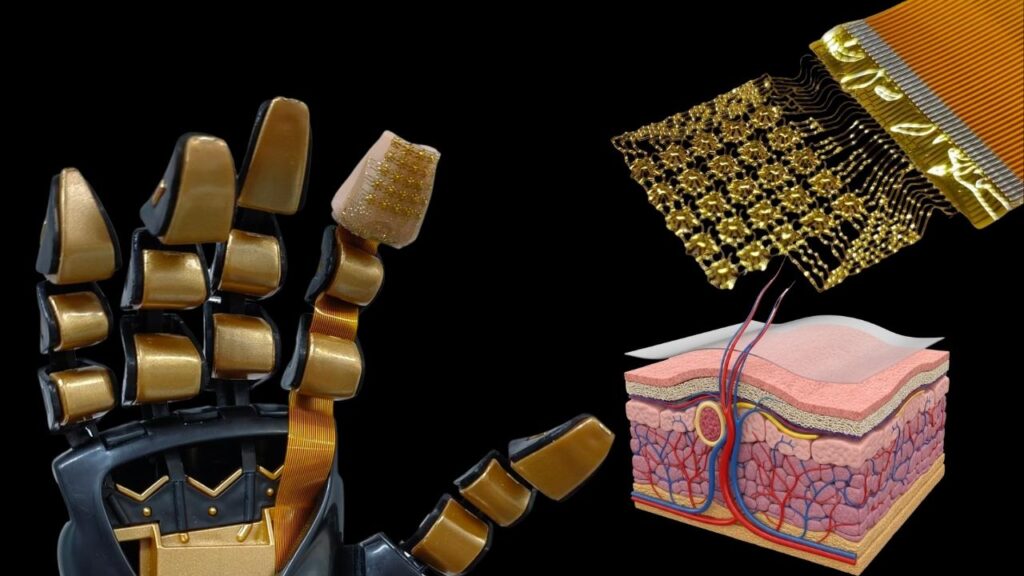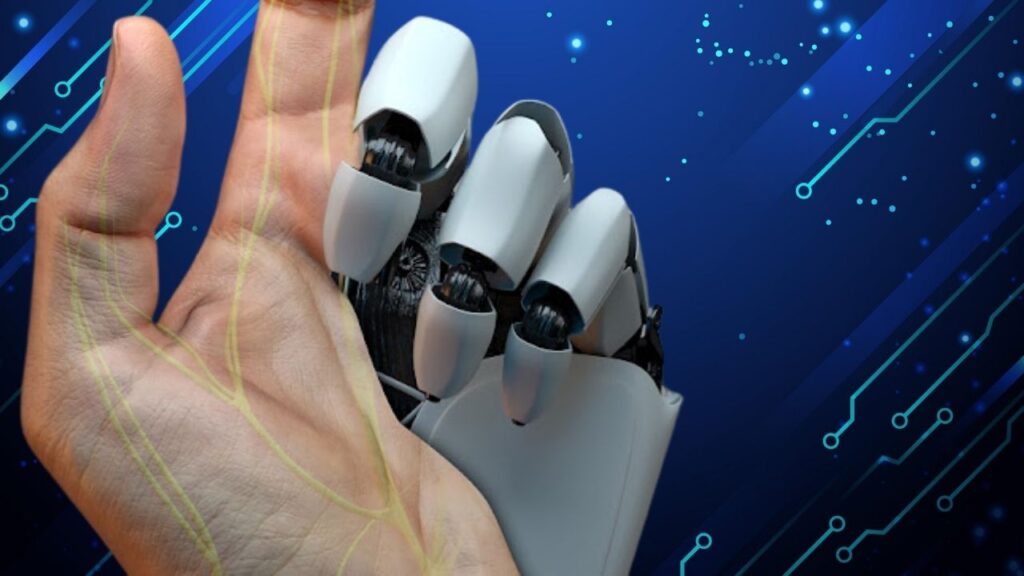China Unveils 3D Electronic Skin Mimicking Human Sensory Perception: In a major technological leap, researchers in China have developed a revolutionary three-dimensional (3D) electronic skin that closely mimics the sensory functions of human skin. Known as “e-skin,” this flexible, multilayered system can detect pressure, friction, and strain simultaneously—just like real human skin.

This innovation isn’t just another lab prototype. It offers the real potential to change how machines interact with people, how prosthetics provide feedback to users, and how robots handle objects in complex environments.
Table of Contents
China Unveils 3D Electronic Skin Mimicking Human Sensory Perception
| Feature | Details |
|---|---|
| Breakthrough | 3D Electronic Skin with human-like sensory perception |
| Sensory Capabilities | Detects pressure, friction, and strain at once |
| Sensor Configuration | 240 sensors in a fingertip-sized area |
| Sensor Size | Roughly 200–300 micrometers |
| Resolution | ~0.1 millimeters, on par with human skin |
| Key Applications | Prosthetics, surgical robots, health monitors, robotics |
| Data Processing | Deep learning algorithms interpret sensor signals |
| Commercial Readiness | Under development; real-world testing ongoing |
China’s introduction of 3D electronic skin marks a turning point in how machines and humans might interact in the near future. With the ability to sense pressure, friction, and strain simultaneously, this innovation replicates the richness of human touch like never before. It’s not just a marvel of engineering—it’s a bridge between biology and technology, one that may redefine everything from prosthetics to robotic surgery.
As development continues and real-world applications expand, this 3D e-skin has the potential to revolutionize how we think about human-machine interfaces, wearable tech, and robotic intelligence.
Understanding the Science Behind 3D E-Skin

What Makes This Skin Different?
Traditional e-skins have limitations—they’re mostly two-dimensional, can detect only one type of stimulus at a time, and lack spatial perception. The new Chinese 3D e-skin solves these limitations with a multi-layer design that mimics the structure of epidermis, dermis, and subcutaneous tissue.
Each layer plays a critical role:
- Epidermis layer houses high-resolution sensors for pressure detection.
- Dermis layer handles friction sensing using a 3D mesh of micro-sensors.
- Subcutaneous layer supports overall structure and manages strain perception.
This biomimicry allows the skin to react naturally to touch, much like the way nerves and cells work in real human skin.
High-Precision Sensors: The Core of E-Skin
One of the biggest innovations is the placement of 240 individual sensors—in a space about the size of a fingertip. Each sensor measures about 200 to 300 micrometers, small enough to detect micro-level stimuli.
These sensors are smartly arranged to reflect the distribution of human tactile receptors. This enables the e-skin to reach a resolution of nearly 0.1 millimeters, helping it differentiate between textures and surfaces almost as finely as our fingertips.
Real-Time Feedback with Deep Learning
But sensors alone aren’t enough. To truly act like human skin, the system also uses deep learning algorithms to interpret and react to incoming signals. When the e-skin comes in contact with an object, it generates massive amounts of data.
Using machine learning, the e-skin can:
- Identify the shape of the object it touches.
- Sense material hardness and surface texture.
- Predict object movement and adjust grip force in real-time.
This capability opens the door to highly responsive applications, especially in robotic surgery, wearables, and AI-driven prosthetics.
Practical Applications: More Than Just a Lab Breakthrough
1. Smart Prosthetic Limbs
Modern prosthetics often lack a “sense of touch,” making daily activities difficult. This 3D e-skin could help prosthetic users feel:
- Pressure when gripping a cup,
- Friction when walking on different surfaces,
- Stretch and strain when moving limbs.
This tactile feedback makes prosthetic limbs behave more like natural ones, improving user confidence and performance.
2. Medical Robotics
In robotic-assisted surgeries, precision and safety are critical. E-skin equipped surgical robots could:
- Feel how hard to grip tissues,
- Detect texture changes in organs,
- Provide surgeons with tactile feedback they currently lack.
This adds a layer of control and safety, minimizing complications during delicate operations.
3. Wearable Health Monitoring

Because it’s soft, flexible, and highly sensitive, this e-skin can be worn on the body like a bandage. It could track:
- Heart rate,
- Breathing patterns,
- Muscle strain,
- Skin temperature.
Such applications could help people manage chronic diseases, recover from injury, or monitor fitness levels—all in real time.
4. Human-Robot Interaction
Service robots are becoming more common—in homes, hospitals, and factories. Adding e-skin allows these machines to:
- Sense when they’re touched,
- Adjust their grip when holding delicate items,
- Respond to subtle movements and gestures.
This makes robots safer and more intuitive for human interaction.
How It Works: A Technical Breakdown
Layer-by-Layer Functionality
- First Layer (Epidermis): Receives external pressure stimuli and translates it into electrical signals.
- Second Layer (Dermis): Uses embedded sensors to measure lateral friction when the surface is stroked or rubbed.
- Third Layer (Subcutaneous Tissue): Detects changes in shape or bending, enabling strain detection.
Each sensor sends signals to a central processing unit where AI algorithms decode them, allowing immediate recognition and response.
Materials and Durability
The e-skin is made from soft polymer materials, ensuring comfort and durability. It’s designed to:
- Stretch without breaking,
- Return to its original shape,
- Maintain performance after repeated use.
Unlike rigid electronics, this skin bends and moves with the body, making it ideal for dynamic environments.
Challenges and Future Improvements
While promising, the technology still faces hurdles:
- Scalability: Manufacturing at commercial scale remains a challenge.
- Cost: The tiny sensors and processing units are expensive.
- Power Supply: Long-term operation requires efficient energy solutions.
Researchers are actively working to solve these issues so the technology can be deployed widely across industries.
India Launches First Full-Stack Quantum Computer Indus: A Major Leap in Quantum Technology
FAQs About China Unveils 3D Electronic Skin Mimicking Human Sensory Perception
Q1: Is this 3D e-skin currently available for use?
A1: No, it’s still in the development and testing phase. Researchers are evaluating real-world performance before commercial rollout.
Q2: How does it compare to regular touch sensors?
A2: Unlike traditional sensors, this e-skin provides high-resolution feedback on pressure, friction, and strain all at once, making it much closer to human skin performance.
Q3: Can it be used in consumer electronics?
A3: In the future, yes. Once cost and durability are optimized, the e-skin could be used in VR gloves, smart wearables, or interactive gaming.
Q4: Does it need software to work?
A4: Yes, it relies heavily on AI software to interpret complex signals and simulate touch sensations.
Q5: What industries might adopt it first?
A5: Healthcare (especially prosthetics and surgery), robotics, and defense are likely early adopters due to their need for precision and tactile response.



















